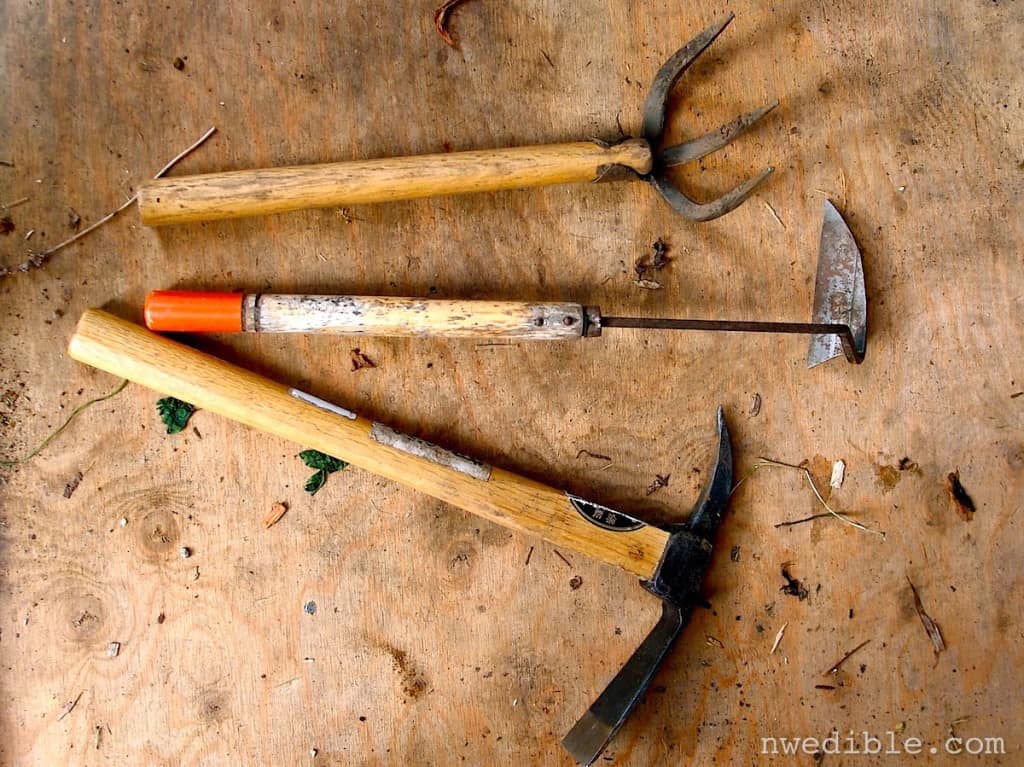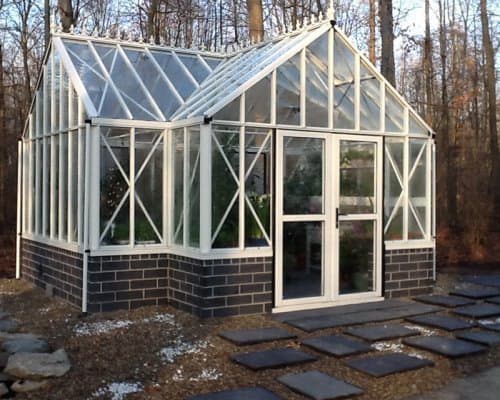I’ve been sitting on a pile of Reader Questions for awhile. I love your questions – they’re the best source of inspiration and really help shape what I write about!
It’s my experience that if one person has a question, 20,000 people have that question. And if I don’t have an answer – one of you will, because readers of this blog are very smart people (also witty, charming, and exceedingly good looking).
So I think it’s time to haul our Reader Question series out of mothballs and tackle a few, don’t you?
This round: expanding a garden in Spring, the best gardening tools, why we homestead, sand in the chicken coop and more.

Best Way To Expand My Garden In Spring?
We are expanding our in-ground garden (yes I should have started in the Fall but with early pregnancy sickness I was too damn lazy). How do I expand the garden this late in the year? Right now it is sod. We have a rototiller and we also own a tractor but everything I have been reading is telling me to not disrupt the soil with those means.
The more I read, the more confused I am. I know you utilize raised beds but was wondering if you had any recommendations. Thank you for reading this drawn out email and thank you for the time you put into your blog.
Steph
Start here. Then, if you have time, watch this.
I’d start by covering your sod where you want to garden with plain brown cardboard. Then I’d make deep-bed lasagna garden type mounds atop the cardboard with every bit of organic matter you can find – old straw, rotten manure, compost, chicken bedding, kitchen scraps, the worm bin contents – whatever you’ve got. Try to get 12-16 inches deep. Then top with a 4-6 inch layer of wood chips. Don’t mix wood chips in – keep them on top. Do this all right atop the cardboard-covered sod.
Then I’d cover the bed mounds with black plastic to help retain heat in winter and encourage microbial life to form as much as possible. You’re basically doing a giant compost-in-place bed at this point.
You can layer in mineral amendments right along with your organic matter no problem. In fact it’s a good idea to add some slow release nitrogen, like seed meal, to the mix as you go, just to counteract the nitrogen tie-up from the decomposition process. If your chicken bedding is sufficiently poop-covered don’t worry about this.
In spring, plant stuff that’s transplant-y, like tomatoes and squash, into the bed and make a kind of “hole” of potting soil within your mounds that you transplant into. This gives the plants a more “finished” soil around their baby roots, then as they grow they will go out into the mound to find what they need.
By next spring the whole thing should be so nicely broken down that you can direct seed without issue.
Advice on Homesteading in Bend, Oregon?
We are moving from Southern California, where we have a 10′ by 10′ backyard garden, to Bend, Oregon and 20 acres. I get to be the gardener in charge of growing as much food as possible for our 2 families. I am super excited but feeling overwhelmed. Any direction you could give this Northwest newbie would be much appreciated!
Jen
I’ve been to Bend a few times. It has a very unique, and a little challenging, climate. You’re basically high desert up there – so expect extreme temperature swings day to night, late frosts, and not too much rainfall.
If the goal is maximum food production, I’d look at setting up a hoop house as early as you can. The added season extension and moderating influence of crop protection for that climate will make a huge difference in your ability to consistently get two crops per year per chunk of land.
Grazing is good in Bend as I recall – goats might be an ideal livestock for you. Be very sensitive about water use and water catchment. The cheapest place to store water is in the ground. If you aren’t familiar with permaculture, please investigate swales on contour for an idea of how effective passive water harvesting can be if you just dig your ditches right.
Geoff Lawton has a series of free videos that might be useful. They are behind a subscription firewall, but they are free and totally worth it. On 20 acres, with thoughtful design, you can build yourself a paradise.
Any gardeners from Bend able to weigh in on this?
What Are The Best Gardening Tools?
Do you have any advice on selecting the best gardening tools?
Chris
I sure do!
First – you need fewer things than you think. Second – some of my favorite gardening tools aren’t super expensive. So while you do generally get what you pay for, there are some really clever tools out there that don’t cost an arm and a leg.
I recommend skipping the “garden sets” that you see at big box stores – you know, they usually have a trowel, a hand fork, some useless cotton gloves, and a bucket. Those things are terrible.

Here are my top 5 essentials:
1. Gloves
For almost everything, you want a soft, flexible glove with nitrile dipped fingers to keep your hands dry and give you great grip. I buy mine 6 pairs at a time, so I (usually) manage to have a complete set clean and dry. Gloves like this are great.
2. Japanese Hand Tools
I far prefer Japanese style hand tools for gardening. I use a Japanese handheld hoe, a Japanese sickle, a claw cultivator and a handheld pick-mattock pretty much every time I’m out in the garden.
3. Pruners
The last name in hand pruners is Felco, and they make some exceedly great tools. But, I discovered last Spring that Costco has released a Kirkland signature brand of hand pruners that are perfect Felco knock-offs. So if you’re a Costco member and you want to save some coin, check out the house brand clippers.
With the money you save, you can buy a Felco folding hand saw – essential for pruning anything too large to tackle with your pruners.
4. A Good Hoe
Slop giggling. We all need a really great hoe.
I strongly prefer the style of hoe called stirrup, scuffle or hula. This type of hoe looks like a metal stirrup, like you’d find dangling from a horse’s saddle. It cuts weed roots on both the forward and back stroke, and I feel strongly that a hoe should do excellent work on both the push and the pull.
I’m not too picky about brand. This one gets good reviews.
5. Metal, Flexible Rake
I love rakes! I have 6, I think. But my absolute, all purpose favorite is my spring metal rake. This is a rake with about 9,000 tines*, all made of thin, flexible metal. Again I’m not a snob about brand – I just want something sturdy, with tines that keep their shape and a handle that will last despite my inevitable neglect. The rake I love is very similar to these.
*Slight exaggeration
How Is The Sand In The Chicken Coop?
Do you still use sand in your coop? Also, what do you recommend to use as a floor in any outside runs? I don’t have grass in the area I want to make an additional run and wondered what would be best to put down.
Ellie
I do still use sand, and I really like it! The coop floor and inner run are both sand, and we’ve been very happy with how it’s performed. Our yard has a high water table and the improved drainage from the sand has helped keep the coop clean(ish) and dry.
In the outside run, I typically use arborists wood chips because they are free, high carbon, and great at absorbing chicken poo. When the chicken manure and wood chips are composted together, they make a really lovely soil amendment. I don’t recommend straw outside in the Pacific Northwest – if it stays wet it tends to mat down and get quite moldy and full of icky spores.
Help! Great Looking Greenhouse?
I need a plan to build a greenhouse that looks great architecturally and is large enough to possibly accommodate some in-ground tomatoes, to extend their growing season.
I know that this may be out of the realm of this forum, but that is what I need. 🙂
Bob
It’s true – once you go greenhouse, you never go back. The greenhouse I have – a small Juliana model – is pretty functional looking. For a really architecturally handsome option, I’d guess you’re hoping for something like this:

Unfortunately, of course, greenhouses like this come with a price tag to match their splash.
LSU’s Ag Department has a pretty comprehensive selection of greenhouse plans. I’d start there and see if anything strikes your fancy, then modify plans as needed to give you the look you’re after.
Do you know of any really great sites for greenhouse plans?
Why Do You Homestead?
Why do you homestead? I mean, I think there are lots of answers to the question and a main one would be to know where our food comes from but why is that important to so many people all of a sudden? I’m pretty fascinated by the ‘why’ of people’s actions.
Melina
Yes, it’s saving money and food confidence and the political statement and the lovely challenge of it all. But more than that, it’s simply that I love the life.
I can’t answer this question for anyone but me, of course, and homesteaders come in all shapes, sizes, and acreage levels. But I feel like I’m more who I really am when I live this way. I feel like my practical life is more aligned with the values that shape my aspirational life. And the feeling of closing that gap makes me happy.
I suppose I could embrace the good fortune that allows me to be a stay at home mom and spend my hours shopping at Target and getting my toes painted (I do live in suburbia, after all), but that kind of thing makes me want to punch myself in the throat. So I do what I do because it feels like a more honest expression of me. And that makes me happy.
Want more? I tackled this issue in a bit more depth here back in 2012.
This answer will be different for everyone – so tell me, why do you homestead?
Want to ask me a question?
It’s easy, and I’d love to feature your question on next month’s Q&A! Just follow these steps to make it easier for me to answer your question:
- Send me an email with “Question for Erica” in the subject line.
- Ask your question in one or two sentences.
- Start a new paragraph and provide any additional details that are relevant to your question.
Thank you!
0
I love 1) being outdoors and 2) making stuff. Then, add the money saving, (equals buying more ‘fun’ stuff :), health benefits, sustainability effects, and endless learning…. voila! paradise in suburbia 🙂
BTW, I think hoity toity Martha Stewart removed the ‘lower-class frugality’ stigma from DIY … and the pure gratification of ‘making’ that spread in the monied classes made her very rich 🙂
Endless learning – yes! This is so key! I constantly have something to do with my brain. I love that!
Did you ever upgrade your smoker? If so, same brand you were considering, and how do you like it (or not)? Thanks!
We got this one in December 2013. Love it! We even smoked our turkey this Thanksgiving!
The link it not opening to a specific product, just the main amazon page. Could you please repost the link? Thanks.
Sorry about that! I think it’s fixed now but if not, here’s the direct url: http://amzn.to/1QbwDEj
Thank you – these are great questions and thoughtful answers.
I was just in the Seattle area over Christmas, and bought a Japanese sickle, Japanese hoe, and hori-hori, and I can’t wait to use them! I’m sure TSA was fascinated by my checked luggage, too…
Carol Deppe also talks about how great the scuffle hoe is. I just can’t think of a use case for me – am I missing something? My kleingarten has a small annual raised bed area for square foot gardening style planting, a large lawn (that will eventually get much smaller), a lot of shrubs, and a few open areas I’m trying to plant in perennials and meanwhile weed and mulch like crazy. Would I use the hoe in the last locations?
I don’t use a hoe in the garden beds. That’s what my hand tools are for. If you are SFG you don’t need anything beyond your Japanese hand tools. I use my hoe in larger open areas like mulched paths, etc. You might find it useful in weeding around established shrubs. The stirup style goes back and forth without really changing the soil layers, but it slices off any weeds that are starting to germinate very effectively. Then I can just let any small weeds rot down in place. But yeah, it totally might not be useful for your situation.
Ok, I can definitely see that use, thank you! I do have mulched paths between the raised beds, but they’re short enough I hope to be able to deal with hand tools. And maybe lots of clover. 🙂
I was wondering if anyone would mention a hori hori. I love mine, just my spell check doesn’t!!! I’m curious on the mental garden rake though ~ I can’t stand those because they are like fingers on chalkboard but I guess I’m actually a plastic girl when it comes to rakes. Last, hoes. Ho ho ho! Love them. And yes, I like mine with a pointy bottom. Ok, that just came out all wrong. Love this post! Fun.
On the question about expanding the garden, I think Erica’s advice is probably best in the long term, but I had pretty decent results tilling grass in place and planting that same year.
1. Don’t use a rototiller. You’ll hate yourself. Use a standard round point spade. Cut, pick up, flip. Try to get the grass all the way on the bottom. Yes this mimics the moldboard plow but we’re not worried about massive erosion on flat, few hundred square feet parcels that are enclosed by lawn or other landscape. Plus we’re going to mulch overtop (depending on climate).
2. What worked well for me: green beans and peas (let the grass decompose at least 2 weeks before seeding), squash (maybe add some finished compost to the hill), and tomatoes. The competition from the grass re-growing is too much for things like greens and the soil won’t be loose enough for root crops though potatoes will do okay if the soil isn’t too clay-ey.
3. What you’ll want: a GOOD hoe. Personal preference there. Erica likes the stirrup hoes, What I like is a light stand-up hoe (the “Coleman” or collinear hoe) and a heavy Japanese style hoe that I carry in my back pocket and whack down any weed the lighter hoe can’t handle.
4. For the really recalcitrant clumps of sod, just pick them up by hand and toss them in the compost rather than trying to break them up.
I grew almost $800 worth of veggies last year and most of that yield was on land that was lawn as late as April.
Thanks David!
I would like to add a few things to your list of essential tools for the garden. A “D” handled fork is irreplaceable and a good quality Dribbler. Also I use a bulb planter for transplanting starts especially if you use Jiffy peat pods for starting plants. Just the right size for planting them. Your choice of a Japanese hand plow is great advise< I don't know how I ever gardened without one. Another good tool is a Japanese Hari Hari knife.
Totally agree on the garden fork. I don’t use a dibber personally, but I know many people who adore them.
Erica, you are right on about gloves. I like to pull on an “underglove” – 9mm thick nitrile glove (reusable if rinsed out , turned inside out to dry, and talcum powdered to slip on again), then add a pair of those leather-palm 5pair-for-$6 sort that take a terrible beating for a few weeks before I toss them. Ruining a too-spendy pair of buttery-soft goatskin gloves in one day’s (ab)use was a harsh lesson. I thank you for the tip about Costco’s take on Felco pruners. I got a Zenport pruner that looks like the Felco 8’s I guard under lock and key. I generally like to weed/chop/whack/pry/dig/plant mostly with a stainless steel hori-hori, a true garden short sword. I have yet to break one of them.
I do the nitrile underglove, too! I’ve never actually managed to reuse a pair, but I love them.
All of the reasons you mentioned for homesteading apply to my husband and me, but I think the most important one in our little world is that we think it’s so important–whether one needs a specific skill at any given time or not–to know how to do things. Many, many things. On the level of personal satisfaction, I love knowing “I grew that,” or “I built that,” or “I sewed that.” On the level of historical awareness, we have been living through a time of unprecedented prosperity and luxury, which has allowed many of us to rely on purchasing, rather than doing. I pray to God this state of affairs is allowed to continue, but should it not, I want to have something to contribute to the world in which we might find ourselves. For the most part though, growing food, and DIY-ing everything I possibly can, just plain makes me more content and happy. It’s the form of creativity for which I am most solidly wired.
It would be going too far to call myself a homesteader, but I do get tremendous satisfaction from growing enough onions that I haven’t had to buy any for nearly 2 years, or from making my own chicken stock from our leftover pastured birds (purchased, not raised). I adored the 10 jars of strawberry jam I canned from my new strawberry patch and the huge heads of garlic I dug up this summer and the pesto I made and froze from my little herb patch. I was endlessly fascinated by the Laura Ingalls Wilder books as a kid, so maybe I’m channeling that in some weird way, but I absolutely love knowing how to do stuff — grow it, preserve it, cook it. I swear, if my husband would let me I’d move us all to an acreage with cows and chickens and pigs and make everyone ride horses to school. Booya!
Just wanted to say thank you for this! I’m planning a move from AZ to WA in the next few years, so I’m stockpiling your tips. We have an urban garden now, but we’re looking forward to expanding!
I’ve lived in Bend for almost 2 yrs and am learning how to garden here. I have a very small backyard garden but here’s what I’ve learned. It can frost and/or snow any month of the year although it’s rare in the summer. It’s dry so you need a reliable source of irrigation. The native soil is quite sterile so needs lots of amendments to add organic matter and nutrients. I didn’t see a worm in the soil until we did an extensive rehab in our small yard. A hoop house is a necessity if you are going to homestead and feed families. Contact the local extension service located in Redmond for expert advice on gardening in this climate. It promises to be just about the exact opposite of gardening in California!
FYI :: Your link to the “flexible metal rake” in #5 under the garden tools question is broken.